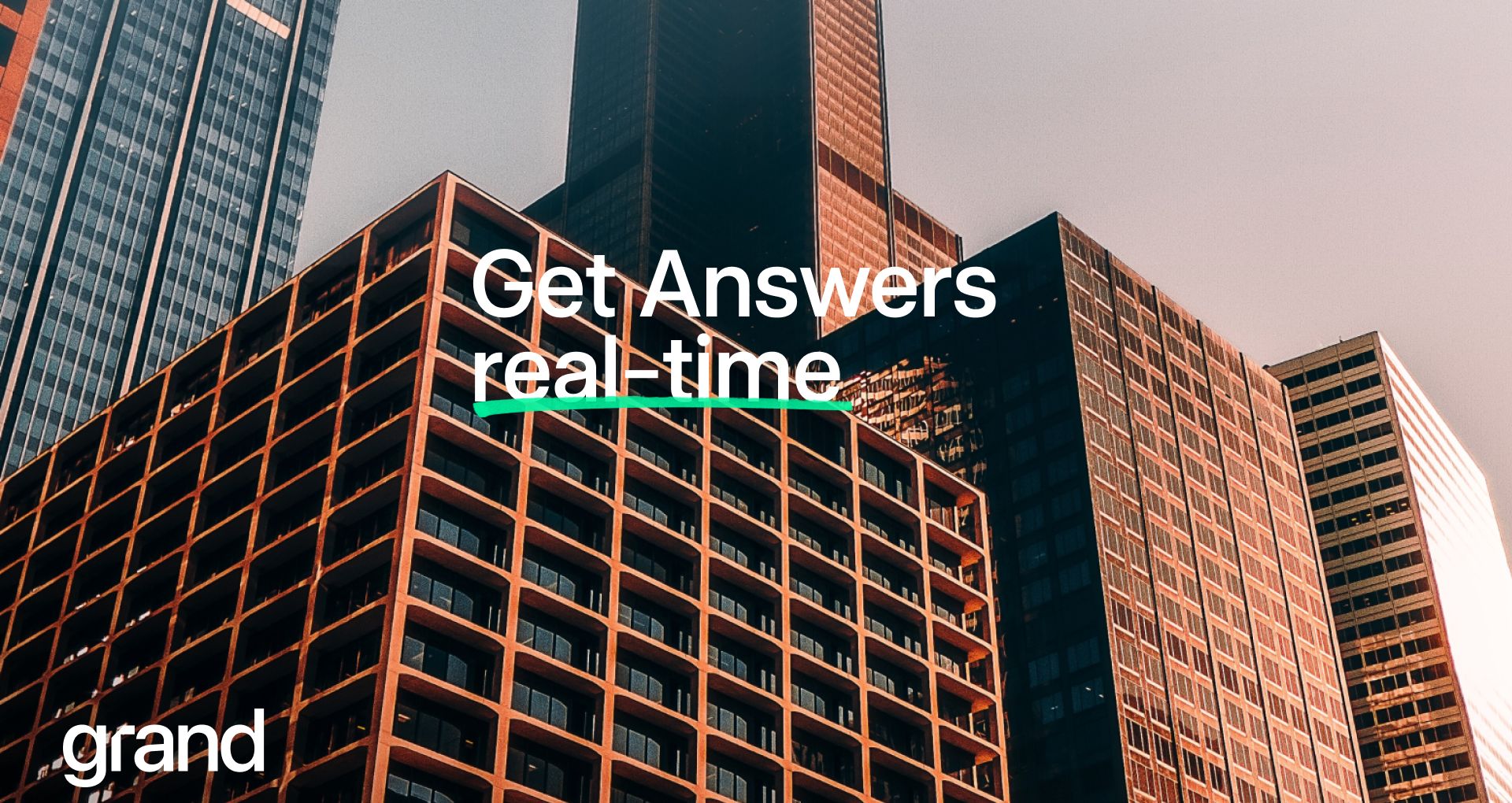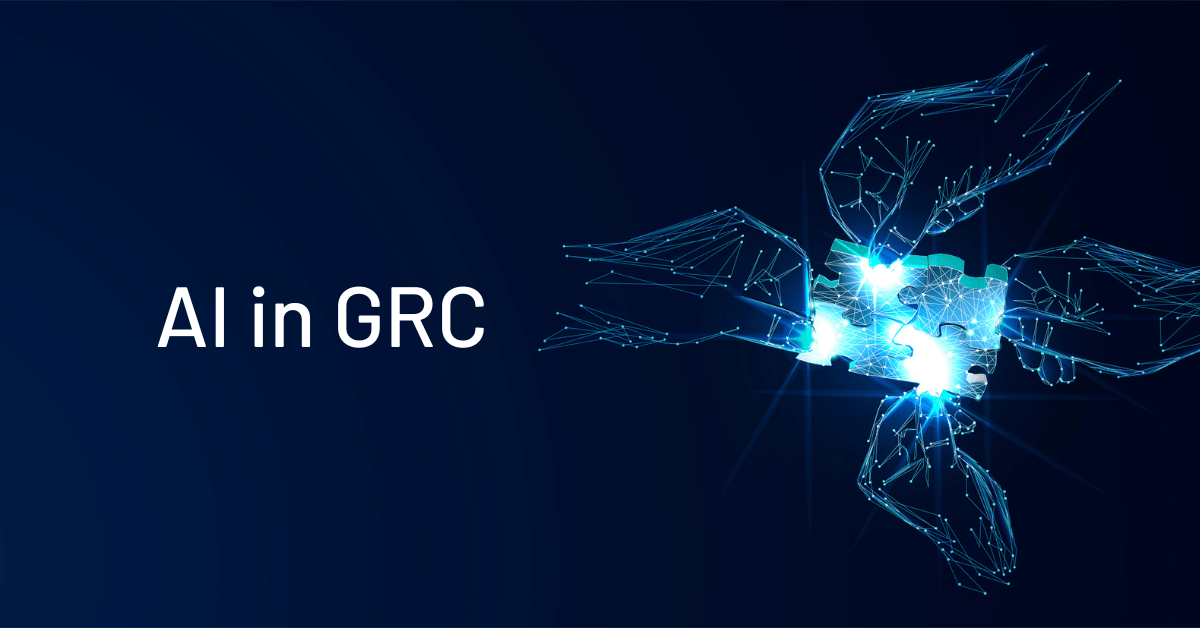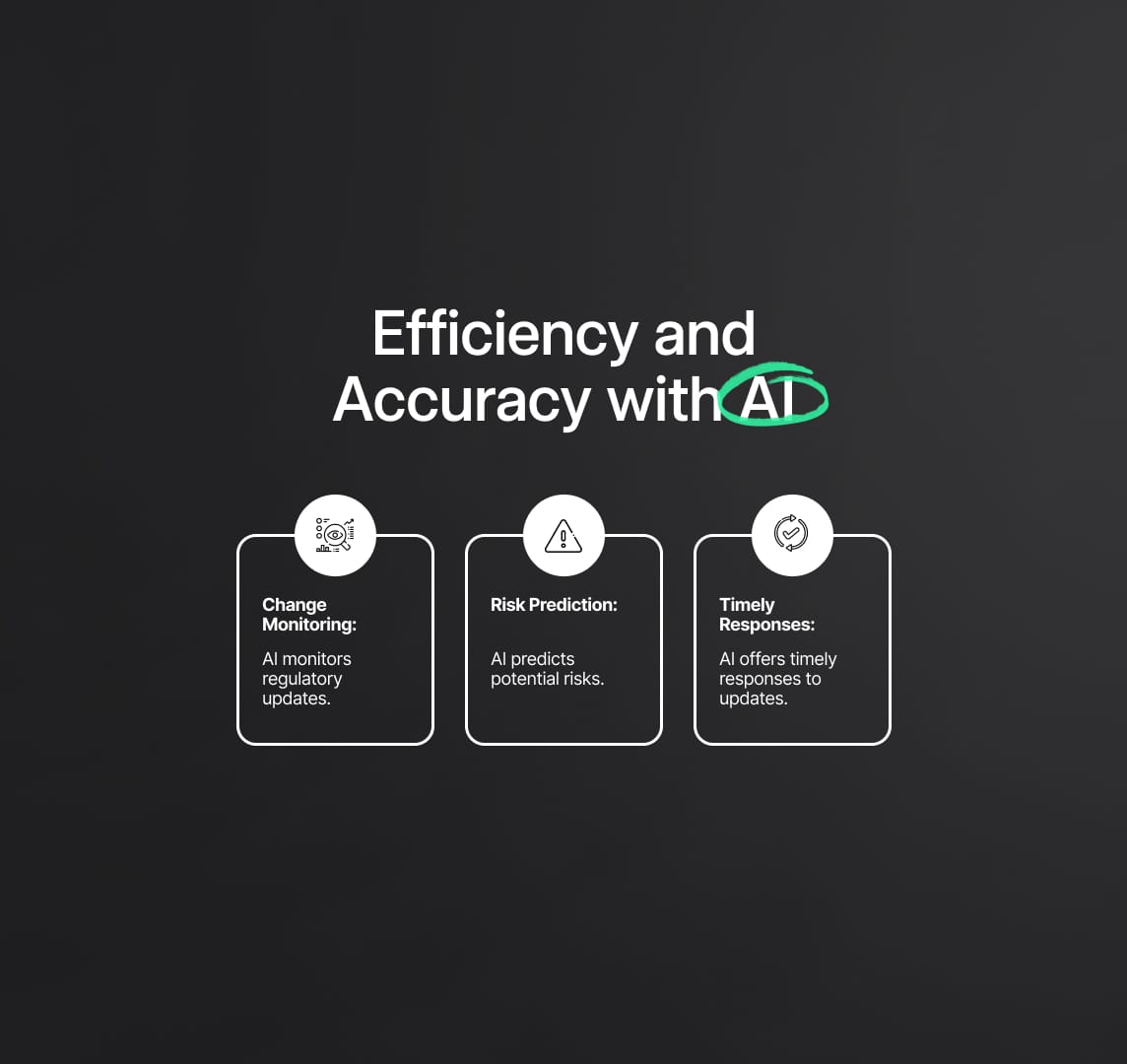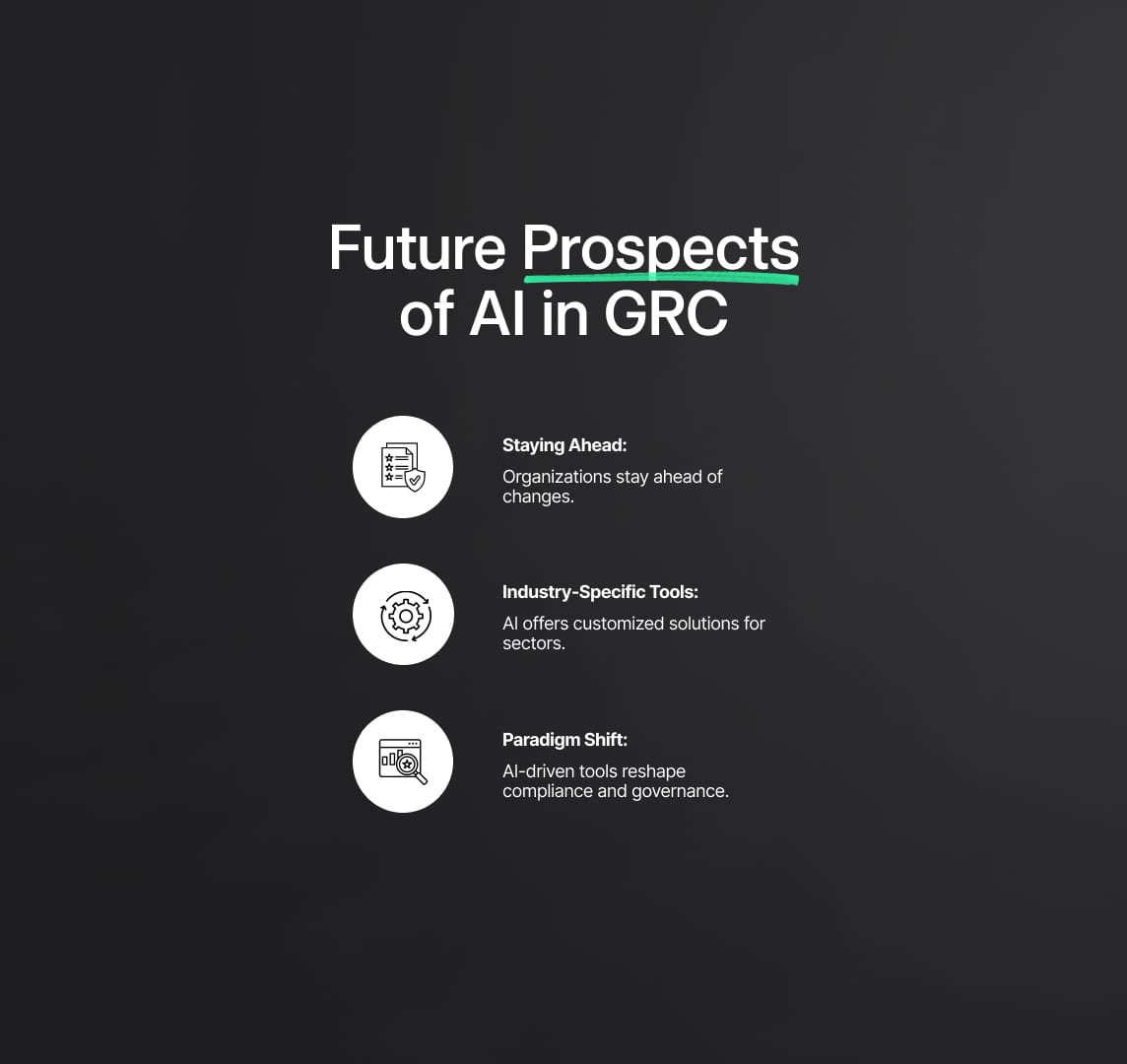How will AI enhance the GRC software solutions performance?
The integration of AI into GRC processes signifies a pivotal shift in organizational governance and risk management. While AI offers unparalleled insights and automation, challenges such as data quality, biases, and the "black box" dilemma persist.

Grand “Answer”:
AI's role in enhancing GRC software solutions is multifaceted. By integrating artificial intelligence, GRC software can benefit from increased efficiency and accuracy across various industries, especially within the financial sector [1]. AI-driven automation can elevate risk management and compliance processes, significantly reducing human errors [1][2]. For governance, AI ensures transparency, safeguarding fundamental rights and upholding ethical standards [1]. Moreover, AI tools embedded in GRC software are adept at navigating intricate liability issues [1]. Nonetheless, addressing and mitigating biases in AI systems is paramount to prevent any unintended discrimination [1][2].
Source
[1]

The Transformational Role of AI in Governance, Risk, and Compliance (GRC) Processes
The Fourth Industrial Revolution, frequently termed Industry 4.0, is not just an incremental advancement in technology but a monumental paradigm shift that is influencing every corner of our global society. Rooted in the amalgamation of digital, biological, and physical worlds, it encapsulates a range of emerging technologies: Cloud Computing, Big Data, 5G connectivity, the Internet of Things (IoT), Augmented Reality (AR), and progressive robotics, to name a few. This revolution goes beyond the mere mechanization of tasks; it integrates cyber-physical systems into the very fabric of industrial operations and societal functions.
As a direct consequence of this ongoing revolution, industries across the globe are undergoing rapid and transformative changes, the likes of which have seldom been observed in historical precedents. Naturally, as the world treads into this uncharted territory, it brings forth a slew of challenges. Among these, the fields of governance, risk, and compliance (GRC) have emerged as particularly critical areas of focus. The magnitude and complexity of global operations today necessitate an intricate framework of guidelines, regulations, and controls to ensure stability and trustworthiness in the system.
Within this evolving landscape, the introduction of Artificial Intelligence (AI) and Machine Learning (ML) emerges as a beacon of hope. The dynamic nature of global operations today, marked by shifting geopolitical landscapes, expanding regulatory jurisdictions, and increasingly intricate compliance nuances, requires tools and technologies that can swiftly adapt, learn, and respond. AI and ML offer a blend of flexibility, scalability, and cognitive understanding, presenting a refined approach towards GRC that's far more agile, adaptable, and proactive than traditional methodologies.

AI's Game-Changing Improvements in GRC
Predictive Analytics and Its Proactive Approach: The evolution of GRC practices over the past few decades highlights a clear trajectory from manual, reactionary processes to automated, proactive systems. Historically, GRC was predominantly about reacting to issues post their occurrence, leading to "firefighting" situations. While valuable lessons were learned post-event, the damage, both reputational and financial, was often significant.
Enter the era of AI-powered predictive analytics. By harnessing the immense computational power and unmatched analytical depth that AI brings to the table, organizations today are equipped to sift through vast oceans of data, spanning from transaction logs to intricate user behavioral nuances. The value proposition is straightforward yet revolutionary. Instead of waiting for risks to materialize and then dealing with their aftermath, organizations can now spot potential patterns and anomalies in real-time. These patterns, often subtle and overlooked by human analysts, act as early warning signals, allowing institutions to fortify defenses, make informed decisions, and mitigate risks before they escalate into tangible threats.
Real-Time Monitoring & Its Significance: Traditional audit and compliance checks, while undoubtedly vital, have their limitations. Rooted in manual methodologies, these processes are labor-intensive, time-consuming, and subject to the innate vulnerabilities of human oversight. These periodic checks, often conducted quarterly or annually, provide only snapshots of organizational health, leaving ample room for issues to fester in the interim.
However, with the advent of AI, the scenario is undergoing a transformative change. AI-driven systems, equipped with sophisticated algorithms, can monitor countless digital transactions in real-time, operating incessantly without fatigue or bias. Every transaction, communication, or operational anomaly gets scrutinized instantly. Such comprehensive surveillance ensures that any non-compliant activity, potential breach, or emerging risk is promptly identified, red-flagged, and brought to the attention of decision-makers. This paradigm shift from periodic checks to continuous monitoring ensures that organizations remain in a constant state of readiness, fortified against threats and compliant with evolving regulations.
The Prowess of Automated Compliance Processes: The sheer volume and complexity of today's regulatory landscape make manual compliance checks a daunting, if not an impossible task. Furthermore, with regulations continuously evolving in response to geopolitical changes, technological advancements, and societal demands, ensuring ongoing compliance can become a logistical nightmare.
Integrating AI into this arena offers a tangible solution. AI, when harmoniously merged with intricate rule-based engines, provides an avenue for automating a wide array of compliance tasks. Advanced AI-driven systems can not only assess an organization's compliance posture against benchmarked standards but also propose actionable remediation strategies in instances of discrepancies. In more mature implementations, these systems can even execute corrective measures autonomously, ensuring that compliance parameters are met without necessitating manual interventions. This automation not only streamlines operations, reducing the manpower and costs associated with compliance checks but also significantly reduces the margin for error.
Dynamic Risk Management through Pattern Recognition: Machine Learning (ML), a subset of AI, possesses the unique capability to discern patterns within data sets. By constantly learning from new information, ML models improve their predictive accuracy over time. In the realm of GRC, this capability is invaluable. When ML algorithms are exposed to relevant and diverse datasets, they tirelessly trawl through this information, identifying patterns that may allude to emerging risks.
Such real-time, dynamic insights enable organizations to remain agile. Instead of static risk management strategies that often become obsolete in the face of rapid changes, ML-driven insights allow GRC professionals to adapt their strategies in real-time. This continuous adaptability ensures that organizations remain a step ahead, anticipating potential pitfalls and adjusting their risk posture accordingly.
Decision-making in the AI Era: Beyond the raw processing power and analytical capabilities, AI's true strength lies in its potential to revolutionize decision-making processes. Emulating cognitive functions akin to human reasoning, AI traverses complex data landscapes, extracting insights that might remain elusive to even the most skilled human analysts.
In the sphere of GRC, where decisions often carry profound implications, the importance of making informed choices cannot be overstated. AI, with its capability to synthesize vast amounts of information, provides GRC professionals with a holistic view of the organization's risk posture. By evaluating data from diverse sources, AI systems can present a multi-dimensional risk profile, highlighting not just the apparent threats but also the nuanced, interconnected risks that might be lurking beneath the surface. Armed with such comprehensive insights, decision-makers can craft strategies that are not just reactive but visionary, ensuring organizational resilience in an ever-changing global landscape.

Challenges and Critiques of AI in GRC
- Data Quality and Reliability: As with any computational system, AI and ML models are fundamentally dependent on the quality of data they ingest. The age-old adage, "garbage in, garbage out," rings true in this context. High-quality, diverse, and relevant datasets are quintessential for training robust models. Any compromise in data quality can lead to inaccurate predictions, misleading insights, or biased outcomes. For instance, if historical data used to train a risk prediction model is tainted with inaccuracies, the AI system may provide flawed risk assessments, potentially leading to costly errors for the organization.
- Ethical Concerns and Bias: The realm of AI is not impervious to biases. If AI and ML models are trained on biased datasets, they are likely to perpetuate and amplify those biases in their outcomes. In the GRC domain, where fairness, equity, and transparency are paramount, biased AI decisions can lead to significant ethical dilemmas and can erode public trust. For instance, an AI system developed to screen potential financial malfeasance might inadvertently target specific demographic groups if its training data reflects historical biases. Organizations must, therefore, be acutely aware of such potential pitfalls and employ de-biasing techniques to ensure that AI-powered GRC tools remain fair and unbiased.
- Over-reliance on Automation: While the automation capabilities of AI provide significant advantages, an over-reliance on these systems can be detrimental. Human expertise, intuition, and judgment remain vital, especially in nuanced fields like GRC. AI should be viewed as a tool that augments human capabilities rather than one that entirely replaces them. There's a real danger in organizations becoming complacent, believing that their AI systems have everything under control, leading to overlooked risks or unchecked non-compliance. The key is to strike a balanced synergy, where AI tools provide insights and automation, but human experts make the final calls based on a holistic view.
- Transparency and the Black Box Dilemma: One significant critique of advanced AI models, particularly deep learning neural networks, is their opacity. Termed as the "black box" problem, these models, while highly accurate, often provide little insight into how they arrive at specific decisions. In GRC contexts, where transparency and accountability are essential, this lack of interpretability can be problematic. Stakeholders, both internal and external, may be hesitant to trust and act on recommendations from systems they don't fully understand. Efforts are being made in the AI research community to improve model interpretability, but it remains a notable challenge.
- Evolving Regulatory Landscape: As AI becomes more ingrained in GRC processes, regulators are turning their attention to the technology itself. AI-specific regulations are being developed to ensure the ethical, transparent, and responsible use of the technology. Organizations leveraging AI for GRC need to stay abreast of these evolving regulations to ensure they don't inadvertently breach guidelines specifically designed for the AI tools they employ.
Future Implications and the Road Ahead
The Continuous Evolution of AI and GRC: The marriage of AI and GRC is still in its relative infancy. As both fields continue to evolve, the depth of their integration will intensify. With advancements in quantum computing, edge computing, and more sophisticated algorithms, AI's potential to revolutionize GRC will reach new heights. Organizations should, therefore, remain vigilant, adapting to technological progressions and ensuring their GRC strategies are in tandem with the latest AI advancements.
Role of Human Expertise: While AI's prowess in data analysis and prediction is unrivaled, the human touch remains irreplaceable. As we tread further into the AI era, the role of GRC professionals will likely shift from manual data crunching to higher-order decision-making, strategy formulation, and ethics enforcement. Continuous training and upskilling will become vital to ensure that the human workforce remains relevant, leveraging AI's capabilities to the fullest.
The Ethical Dimension of AI in GRC: As mentioned earlier, the potential biases and ethical challenges posed by AI cannot be overlooked. The future will likely see the development of robust ethical frameworks designed specifically for AI in GRC. Organizations would do well to proactively engage in these discussions, championing ethical AI usage and setting industry standards.
Collaboration Between Tech and GRC Experts: A multidisciplinary approach will be paramount for the successful integration of AI in GRC. Technologists and GRC professionals must foster a collaborative environment, where the former brings technological expertise, and the latter provides domain-specific insights. Such synergistic collaborations will be the cornerstone of crafting AI-driven GRC strategies that are technologically sound and contextually relevant.
The integration of AI into GRC processes marks a watershed moment in the evolution of organizational governance and risk management. While challenges exist, they are surmountable with concerted effort, research, and collaboration. Organizations poised to reap the benefits of this integration will be those that remain agile, ethical, and forward-thinking, positioning themselves at the nexus of technology and robust governance.
This comprehensive study has aimed to shed light on the transformative impact of AI on GRC, while also emphasizing the inherent challenges and the road ahead. As we continue to delve deeper into the Fourth Industrial Revolution, it is imperative to harness the potential of AI responsibly, ensuring that GRC processes not only become more efficient but also more equitable and transparent.

Grand Answer: Your AI Partner
Designed to support compliance officers, legal counsels, and other professionals responsible for adhering to regulatory standards, Grand Answer aims to facilitate an efficient and straightforward compliance process.
Reduce your
compliance risks


